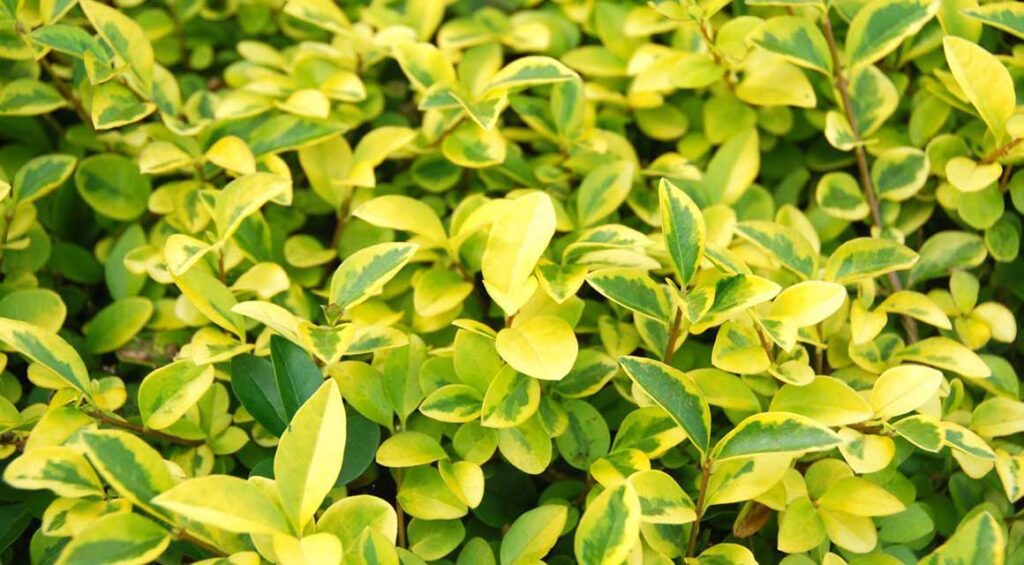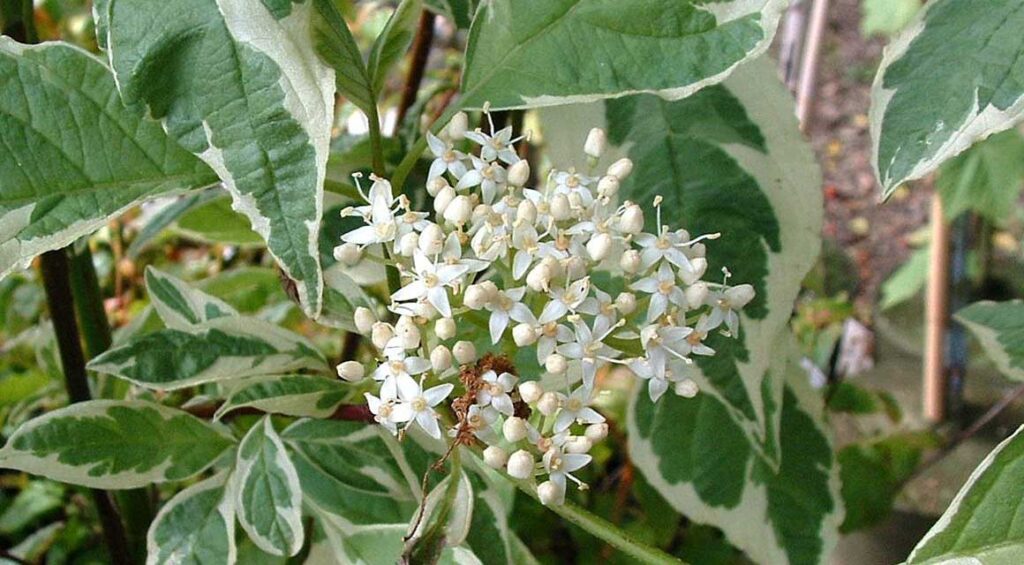Ask garden owners about the ideal color for their hedge plants, and the answer is often “green”. However, green is not the only leaf color that can make a beautiful hedge. There are several hedge plants with bi-colored leaves. Such hedge plants often give the garden a lively look also because the second leaf color is usually much lighter than green. And such a bicolored leaf may sound like something special that only one or two plants have, but we have several types of hedge plants with bicolored leaves in our assortment.

Contents
Yellow with a green heart: the colorful privet hedge.
Golden privet (Ligustrum ovalifolium ‘Aureum’) is a cultivated form of privet, making it perfect for a privet hedge with a more formal shape. Hedge privet has smaller leaves than regular privet, making it easy to cut back into a tight shape. Still, the privet will always look more cheerful than the average privet hedge and that’s because of its beautiful yellow leaf edge. And because the privet is semi-evergreen, the privet can even grow into a cheerful looking privacy hedge as long as it doesn’t get too cold in the winter.
Perhaps the best thing about privet is that you have some control over how yellow the leaves eventually turn. The sunnier the location of your privet hedge, the wider the yellow edge on the leaves will become. In a place where your privet hedge is in full sun for most of the day, some leaves may even turn completely yellow. In a shady spot, the green will take over the leaves.
Privet can withstand wind, calcareous soil and even polluted city air. Only soils that store too much water, which can not drain well, are unsuitable for this particular privet.

Spotted leaves: the Japanese aukube
A colored leaf margin can be beautiful, but a spotted leaf can also give your garden a unique look. If that appeals to you, the Japanese aukube (Aucuba japonica) is definitely worth a look. Many garden owners have fallen in love with the leaves of Japanese Aukube ‘Variegata’ and the slightly larger leaves of Japanese Aukube ‘Crotonifolia’ and it’s not hard to see why. The sheen that the leaves of these evergreen hedge plants have is somewhat reminiscent of the cherry laurel but the yellow spots on the leaves give the Japanese aukube a character all its own.
Unlike most hedge plants with bicolored leaves, sunlight has little effect on the yellow content of the Japanese Aukube’s leaves. In fact, the best location for these beautiful hedge plants is in partial shade. Sunlight brings out the shine of the leaf better, but if the Japanese aukube is left in the burning sun for too long, the leaf can turn black.
Japanese aukube is very hardy and thrives in almost any soil type. Good drainage is required as it does not tolerate wet feet. The Japanese aukube can also have problems with prolonged drought. So keep a close eye on the soil around your hedge plants and give plenty of water when needed.

Different options with the creeping spindle
In our assortment you will find three different species of creeping spindle (Euonymus fortunei) and all three are evergreen hedge plants. The creeping spindle have the green leaf color you would expect from this type of hedge plant, but the other two have a remarkably lush appearance. The creeping spindle ‘Emerald ‘n Gold’ have a yellow leaf margin, while the leaf margin of the creeping spindle ‘Emerald ‘n Gaiety’ is white. The bicolored varieties of creeping spindle only grow to a maximum height of 60 inches, but you can combine them for an extra colorful hedge.
More sunlight also means that the colored edges of the bicolored creeping spindle’s leaves become wider. By the way, creeping spindles thrive just as well in shade or partial shade, they will just have greener foliage as a result. The creeping spindle is not only evergreen, but also relatively winter-hardy, although it can happen that the leaves turn a bit red in above-average winters.
Because creeping spindles are evergreen, have small leaves and remain quite small, they are also very popular with amateur gardeners looking for a boxwood replacement. Creeping spindle ‘Emerald ‘n Gold’ and creeping spindle ‘Emerald ‘n Gaiety’ are thus a great alternative for a box hedge, as they look very special.

Flower and two colors of leaves: the redwood dogwood.
So far, we’ve always had it about evergreen hedge plants. The redwood dogwood ‘Elegantissima’ (Cornus alba ‘Elegantissima’) loses its leaves in winter, but offers a versatile play of colors. This begins with the leaves. The leaves of the redwood dogwood are beautifully shaped and have a magnificent silvery-white edge that is best seen in summer. At the beginning of summer, the creamy white flowers of the redwood dogwood add a pop of color. After flowering, the redwood dogwood produces white to red berries that are sure to be appreciated by birds in your area.
Because of its maximum height of about 1.50 meters and the fact that it loses its leaves in the fall, the redwood dogwood is not suitable as a privacy hedge. However, it has much more ornamental value in the later months of the year than most other flowering hedge plants. First, the leaves turn a beautiful red to purple in the fall, and then the redwood dogwood shows off its red branches. This adds a surprising amount of color to the garden, even if it is bare.

